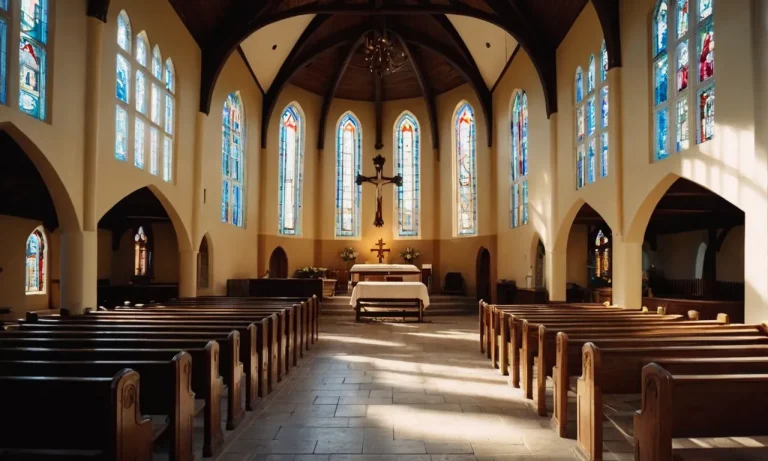The Mountain Where Jesus Prayed: Understanding The Significance Of The Mount Of Olives
The biblical account of Jesus’ life documents several instances where he retreated to the solitude of a mountain to pray and commune with God. If you’re looking for a quick answer, the primary peak where Jesus went to pray is the Mount of Olives, located just east of the Old City of Jerusalem.
In this comprehensive article, we will explore the history and religious significance of the Mount of Olives. We’ll discuss how this mountain ridge factored prominently into key events during Jesus’ life and ministry.
We’ll also highlight the enduring spiritual importance of this site for Christians even today.
The Geographic Significance of the Mount of Olives
Physical Features and Location Relative to Jerusalem
The Mount of Olives is a mountain ridge located east of the Old City of Jerusalem. At just over 2,600 feet tall, it towers over the Kidron Valley and provides incredible views of the Old City and Temple Mount area. The mount gets its name from the olive groves that once covered its slopes.
Today, Jewish cemetery plots, churches, mosques, and gardens cover much of the hillside.
The Mount of Olives has immense geographic significance given its proximity to Jerusalem’s Old City. It sits directly opposite the Temple Mount, with the Kidron Valley separating the two. This close location has made the mount an important site for both Jewish and Christian worship and rituals over the centuries.
References to the Mount of Olives in the Old Testament
The Mount of Olives has been an important biblical site since ancient times. It is first mentioned in 2 Samuel 15:30, when David flees Jerusalem and walks up the mount barefoot and weeping. The mount is also referenced as the site where King Solomon built shrines for the foreign gods of his wives (1 Kings 11:7).
The mount continues to play an important role in later biblical events. According to Zechariah 14:4, the Lord will return to the Mount of Olives and split it in two, providing an escape route for those fleeing Jerusalem’s destruction.
Given these and other biblical references, the Mount of Olives has long been viewed as a sacred place of great religious significance by Jews, Christians, and Muslims alike.
The Mount of Olives in the Life of Jesus
Jesus Visited the Mountain to Pray
According to the Gospel accounts, Jesus frequently visited the Mount of Olives to pray and find solitude. He would retreat to this mountain, which rises up directly east of the Old City of Jerusalem, to commune with God the Father and prepare for His ministry (Mark 1:35, Luke 22:39).
In some sense, the Mount of Olives served as Jesus’ sanctuary and source of spiritual strength and guidance.
Palm Sunday – Jesus’ Triumphal Entry
On Palm Sunday before His crucifixion, Jesus descended the Mount of Olives as He began His triumphal entry into Jerusalem. The crowds welcomed Him by waving palm branches and shouting “Hosanna! “, acknowledging Him as the long-awaited Messiah (Matthew 21:1-11).
This location marked a critical moment when Jesus presented Himself to the people of Jerusalem as their prophesied King.
Garden of Gethsemane – Jesus’ Agony and Betrayal
After the Last Supper, Jesus retreated to the Garden of Gethsemane, located on the lower slopes of the Mount of Olives, to pray in agony about His coming crucifixion. He was then arrested there by Judas’ betrayal (Luke 22:39-53).
For Jesus, the Mount of Olives became a place of both spiritual connection with the Father and great human vulnerability–a pivotal site of sanctification and sacrifice.
The Mount of Olives as a Significant Christian Site
A Site of Pilgrimage and Worship
The Mount of Olives has been a major site of Christian pilgrimage and worship for centuries. As the location of Christ’s ascension into heaven and other key events in the Gospels, it holds deep spiritual meaning for Christians. Some key details:
- Jesus spent time praying on the Mount of Olives the night before his crucifixion (Luke 22:39-46). The Church of All Nations stands on the traditional site of Christ’s prayer in the Garden of Gethsemane.
- After his resurrection, Jesus ascended into heaven from the Mount of Olives according to Acts 1:9-12. The Chapel of the Ascension marks the traditional site.
- For centuries, Passion Plays reenacting the events of Holy Week have been performed on the slopes of the Mount at Easter. Even today, Palm Sunday processions come from the Mount.
- The mount provides panoramic views of Jerusalem and the Temple Mount area, adding to its draw for pilgrims wanting to walk in Christ’s footsteps.
With this rich biblical history, the Mount of Olives has attracted many churches, monasteries, and shrines over the centuries. Even tombs were built here based on the Jewish belief that the Mount of Olives is where the resurrection of the dead will begin.
For Christians worldwide, a pilgrimage to the Mount of Olives offers a powerful way to connect to the central events of their faith.
The Future Site of the Second Coming of Christ
Beyond its history, the Mount of Olives also has eschatological significance for Christians who believe it will play a central role in the end times events. Here are some key beliefs about the future of the Mount:
- In the Book of Zechariah 14:4, the Mount of Olives is named as the place where the Messiah will first set foot when he returns in power and glory.
- The return of Jesus Christ will follow a period of great tribulation on earth, as foretold in the Book of Matthew 24:29-30.
- Jesus will descend on the Mount of Olives and travel to the Kidron Valley, where he will fight enemies attacking Jerusalem, according to prophecy.
- Many Christians believe the dead will be resurrected from their graves on the Mount when Christ returns, as described in 1 Thessalonians 4:16.
While interpretations differ, these prophecies give the Mount of Olives apocalyptic importance. Its role as the staging ground for the Second Coming adds to its draw as a site of great future significance in God’s plans. That lends spiritual meaning for Christians beyond its already rich history.
Conclusion
For centuries, the Mount of Olives has been a site of tremendous spiritual significance for Christians. Biblical accounts clearly document how Jesus retreated to this mountain ridge overlooking ancient Jerusalem for solitude, prayer and critical moments in his ministry.
Even today, with its panoramic views and key sites like Gethsemane, the Mount of Olives continues to draw Christian pilgrims from around the world who come to walk in Jesus’ footsteps and reflect on his life.








